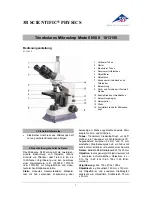
Axio Imager 2
INTRODUCTION
ZEISS
Notes on device safety
01/2016
430000-7544-001
9
Operation of the devices in explosive environments is not permissible. Operation of the devices
is only permitted in closed rooms.
Gas discharge lamps, e.g. HBO 50; HBO 100 or XBO 75, emit ultraviolet radiation, which can
cause burns to the eyes and skin. Therefore, never look directly into the light of these lamps
and avoid direct, unprotected incidence of their light on your skin. When using the microscope,
always use the protective devices belonging to the instrument (e.g. special attenuation filters or
the fluorescence shield). When they are hot, gas discharge lamps are under high internal
pressure. Therefore, change them only when they have cooled down, and make sure protective
gloves and a face guard are worn.
When fluorescence filters are used, the heat protection filter for heat emitted by the
microscope illuminator must not be removed, since fluorescence filters are sensitive to heat and
their performance could be impaired.
Avoid touching the hot lamp housing. Always disconnect the power plug before changing the
lamps and allow the instrument to cool down for approx. 15 minutes.
Dust and dirt may impair the instrument’s performance. The instrument must be effectively
protected from such influences and covered with the dust cover when not in use. Always check
whether the instrument is switched off before you cover it.
Clogged or covered ventilation slots may lead to heat build-up that will damage the device and,
in extreme cases, cause a fire. Always keep the ventilation slots clear and ensure that no objects
enter or fall into the instrument through the ventilation slots.
The instruments may only be operated by trained personnel who must be aware of the possible
dangers involved with microscopy and the particular application concerned. The Axio Imager
microscopes are high-precision instruments that can be impaired in their performance or
destroyed if handled improperly.
The LED illuminator is a class 2M device. Do not look directly into the LED light.
Do not dispose of defective instruments in regular domestic waste; these should be disposed of
in accordance with prevailing legal requirements.
Specimens should also be disposed of in compliance with the prevailing legal requirements and
internal operating procedures.










































